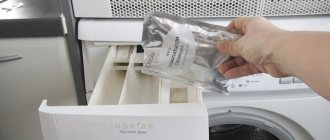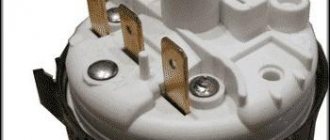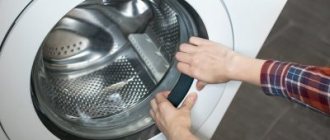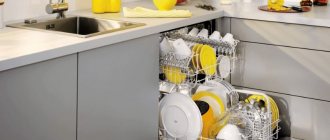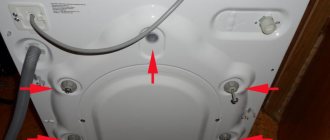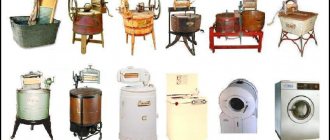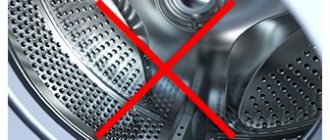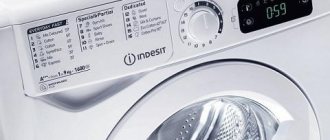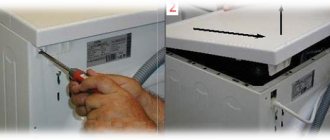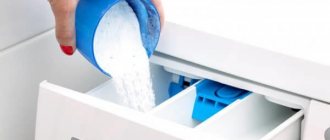Every buyer, wanting to purchase a washing machine (hereinafter also referred to as ASM, SM), wants to receive information about its characteristics. Often, users pay attention to the number of programs, design and maximum drum load, without thinking about other indicators. This happens because most future owners are not aware that ASMs are classified according to washing, spinning and energy consumption efficiency. The power of a washing machine is one of the important indicators that determine its efficiency and quality.
Unified classification of energy consumption of European-made washing machines
Subtypes of machine energy consumption
Based on the information provided, they are guided by estimating the efficiency of the unit. You can obtain information by reading the corresponding markings located on the body of the unit. Europe invented 7 levels of energy consumption, marked with Latin letters: A; IN; WITH; D; E; F; G. Plus is added to units whose skills exceed the standard limits.
- Installations A are extremely economical; equipment of subtype A requires 0.17 - 0.19 kWh.
- The consumption of a class B washing machine varies between 0.19 - 0.23 kWh.
- Type C devices consume slightly more resources, 0.23 – 0.27 kWh.
- Household appliances of subtype D are classified as economical category; the level of “fence” varies between 0.27 – 0.31 kWh.
- Devices demonstrating E-F indicators are characterized by increased demands, the consumption level is 0.31–0.35 kWh, 0.35–0.39 kWh, respectively.
- Let's call class G devices uneconomical; they are capable of using more than 0.39 kWh, which is extremely high and unjustifiable.
- The antipode, the complete opposite, is the technology of category A+. “Occupies” less than 0.17 kWh, ensuring product competitiveness.
How much a washing machine consumes is determined by laboratory tests, and the equipment is assigned the appropriate level.
"P" value
Power, which determines the rate of energy consumption, plays a key role. Washing machines show performance in the range of 2–4 kW. High numbers are due to the need to heat water and impose special requirements on connecting equipment. Due to restrictions regarding the current carried by the wires. The power of the washing machine is 2.2 kW, the current consumption is 10 A. The throughput of copper wires is 14 A/mm 2, the parameter for aluminum wiring is 10 A/mm 2. The device, which consumes 2.2 kW, is connected after first calculating the cross-section of the wires.
If P equipment exceeds the cable transmittance, you will need to convert the indicator into amperes using the formula: N (kW) × 4.35 = A. Empirically it looks like this: 4 kW × 4.35 = 17.5 A. Divide the result by the number of square millimeters, stated above. Compare the necessary information. We conclude: connecting a machine with power
, is performed using aluminum wire with a core cross-section of 2 mm 2 or copper wire with a cross-section of 1.5 mm 2.
Maximum power to energy ratio
Now consider the ratio of the maximum required power to the energy consumption of the cycle. Greatest
unit fluctuates between 2.15–2.3 kW. At the maximum setting of the physical quantity, consumption is 0.94-0.95 kWh. The indicators for devices of classes B and C are identical. The power consumed by a washing machine rarely exceeds 2.2 kW, allowing one to count on resource consumption of 0.9 kWh. Fundamental differences are felt in the case of equipment belonging to subtype D; in this case, the “max” power level can also be 2.2 kW. Consumption reaches 5.2 kWh, which is extremely high.
Video
From this video, readers can learn how to independently measure the power consumed by a washing machine at different stages of washing using a Power Meter.
About the author:
Egor Taranenko Electronics engineer with many years of experience. For several years I was engaged in organizing the repair of household appliances. I am glad to share with readers my knowledge in the field of operation and repair of devices. Loves sport fishing, water tourism and travel.
Found a mistake? Select the text with the mouse and click:
Did you know that: Before removing various stains from clothing, you need to find out how safe the selected solvent is for the fabric itself. It is applied in a small amount to an inconspicuous area of the item from the inside out for 5-10 minutes. If the material retains its structure and color, you can move on to stains.
Stretch ceilings made of PVC film can withstand from 70 to 120 liters of water per 1 m2 of their area (depending on the size of the ceiling, the degree of its tension and the quality of the film). So you don’t have to worry about leaks from neighbors above.
There are special traps to combat moths. The sticky layer with which they are covered contains female pheromones that attract males. By sticking to the trap, they are eliminated from the reproduction process, which leads to a decrease in the moth population.
Fresh lemon is not only suitable for tea: clean dirt from the surface of an acrylic bath by rubbing with half a cut citrus, or quickly wash the microwave by placing a container of water and lemon slices in it for 8-10 minutes at maximum power. The softened dirt can simply be wiped off with a sponge.
The habit of using an automatic washing machine “sparingly” can lead to the appearance of an unpleasant odor in it. Washing at temperatures below 60℃ and short rinses allow fungi and bacteria from dirty clothes to remain on internal surfaces and actively multiply.
If your favorite things show the first signs of gestation in the form of untidy pellets, you can get rid of them using a special machine - a shaver. It quickly and effectively shaves off clumps of fabric fibers and returns things to their proper appearance.
Threads made of gold and silver, which were used to embroider clothes in the old days, are called gimp. To obtain them, the metal wire was pulled for a long time with pliers to the required fineness. This is where the expression “to drag out the rigmarole” came from - “to do long, monotonous work” or “to delay the completion of a task.”
The easiest way to remove scale and carbon deposits from the soleplate of the iron is with table salt. Pour a thick layer of salt onto the paper, heat the iron to maximum and run the iron over the salt bed several times, applying light pressure.
The dishwasher cleans more than just plates and cups. You can load it with plastic toys, glass lamp shades and even dirty vegetables, such as potatoes, but only without using detergents.
Calculation of electricity consumption based on the power of the device
What do the installations mean for the average consumer in terms of the number of kilowatts needed during the month? The following simple diagram will help to simplify the understanding of the issue: 1000 Wh = 1 kWh. In other words, the device has the greatest
4000 W, 1 hour of operation will consume 4 kWh of electrical energy. Measurements of the required quantity
one cycle is conditional. They inform the consumer how much energy the device will consume when operating for an hour, heating water to a temperature of 60°C.
Therefore, the power consumption of the washing machine is determined by additional factors:
- fabric type;
- water temperature;
- number of revolutions;
- drum loading level.
If the unit says: “takes” 0.94 kWh, this is how much the device will consume during an hour of operation at a water temperature of 60°C, fully loaded with cotton fabric. If the procedure takes place at a temperature of 30°C, all other conditions being equal, 0.47 kWh is consumed.
How many kilowatts of energy does a washing machine consume per hour?
One of the important trends of the modern world is energy saving. Today, manufacturers use the latest technologies in the manufacture of washing machines. energy efficiency when purchasing household appliances . The device will be more economical if this indicator is high. Below we will take a closer look at what electricity is spent on when operating the machine, and how to reduce costs.
- Top 3 most economical washing machines
- What is electricity used for?
- Electric motor
- Pump
- Tubular electric heater (TEH)
- Control block
- Energy consumption classes (energy efficiency)
- How to determine how much energy a washing machine uses
- What affects how many kilowatts a washing machine consumes?
- Top 3 most economical washing machines A++ and A+++ class
- Weissgauff WM 4126 D
- Electrolux PerfectCare 600 EW6S4R06W
- Bosch WAT 28461 OE
- How to save money?
Marking
Since 1992, following a directive issued by the European Community, all foreign manufacturers are required to attach a uniform label with the marking to the device. Therefore, now you can find such a sticker on every foreign-made model. With its help, it is easy to determine the energy consumption class to which the machine belongs.
The letters are arranged in alphabetical order (A to G) from top to bottom. Moreover, if the device represents a product group marked “+” or “++”, then this group will be located above the rest. Each of the designations is highlighted in a specific color: energy-efficient classes are marked in shades of green (from dark to light), the least economical groups are marked in shades of red.
Top 3 most economical washing machines
| Place | Model | ||
| 1. | Weissgauff WM 4126 D | Prices | Review |
| 2. | Electrolux PerfectCare 600 EW6S4R06W | Prices | Review |
| 3. | Bosch WAT 28461 OE | Prices | Review |
0.13 - 0.20 kW per hour per 1 kg of loaded laundry . That is, washing bed linen for two hours in a machine with a load of 6 kg will cost
8 rubles at average electricity tariffs
Comparison table of characteristics
Let's move on to a more visual representation of the models discussed above and place them in the table.
| Name | Loading, kg | Water consumption, l | Noise (washing), dB | Noise (spin), dB | Dimensions, cm | Weight, kg |
| Bosch WLG 20261 OE | 5 | 40 | 52 | 77 | 60x40x85 | 61 |
| Bosch Serie 6WLT2446S | 7 | 38 | 56 | 77 | 60x45x85 | 63 |
| Bosch WHA122XEOE | 7 | 45 | 52 | 75 | 60x45x85 | 62 |
| Bosch WLL24241 | 7 | 42 | 56 | 77 | 60x45x85 | 63 |
| Bosch WLL2416EOE | 6 | 41 | 56 | 77 | 60x45x85 | 63 |
| Bosch WLT24465OE | 6,5 | 51 | 52 | 75 | 60x45x85 | 62,5 |
| Bosch WAT 28461OE | 9 | 63 | 49 | 75 | 60x59x85 | 69,5 |
What is electricity used for?
The washing machine consumes different amounts of energy. This depends on the selected washing program. Electricity is spent on heating water, operating the drum, cycle intensity, and so on. The total power of the washing machine is determined by the sum of the powers of the main components.
These include:
- Electrical engine;
- Control block;
- heating element – heating element;
- drain pump.
Washing machine energy consumption
Electric motor
consumes the most electricity . Modern washing machines have one of the following types of electric motors:
- brushless;
- collector
Models from LG, Bosch and others are equipped with brushless electric motors . They consume 20% less energy, are quieter, and can last for over 10 years without breakdowns. Commutator motors are very noisy and have a short service life because their brushes wear out. Washing machine power values in kW range from 0.4 to 0.8.
Pump
This mechanism is designed to pump water out of the tank at different stages of washing. It all depends on the chosen program. Basically, a pump is an impeller rotated by a small electric motor . Its blades draw water into the body at the inlet and push it out into the drain hose at the outlet. The power consumption of the pump ranges from 20 to 40 W.
Unplanned energy expenses
As a rule, the reason for additional and completely unjustified energy costs are little things that people do not pay attention to. Here are some tips from experts that will allow you to avoid unnecessary financial and energy costs:
- When finished washing, unplug the machine. Even in standby mode, significant electricity consumption is possible.
- Load the drum completely. If you neglect this rule, you are guaranteed an increase in energy costs by 10-15%. One full wash is much more cost-effective than several small washes.
- Choose the correct washing mode. If this is not the case, you will additionally use up to 30% of kilowatts.
- Don't overuse the dryer. During warmer months, air dry your laundry. Free natural energy - why not take advantage of it?
Admit it, have you paid attention to such “little things”? - But these are real items for saving. Therefore, properly organize the process of caring for your things using household appliances, and if you are selecting a new model for use, check the power of the washing machine in kW and take the most economical device.
Energy consumption classes (energy efficiency)
The energy efficiency class determines the amount of energy that the device uses. The higher it is, the more effective the costs are. This parameter is considered one of the main indicators of the quality of the device. On average, the power of a washing machine can reach 4 kW. Today, many are trying to save resources, so they tend to use household appliances that belong to class A or B.
The presence of the letters F or G characterizes the quality of energy saving as poor and very poor, D and E – normal and satisfactory. Before assigning an energy saving class for parameters such as washing, spinning, and energy efficiency, a comparison is made with the standard. They have a special installation with constant performance indicators. The technique under study is compared with it.
Energy efficiency class table
| Class | Power consumption, kW/h per 1 kg of laundry | Energy efficiency index, % |
| A, A+, A++, A+++ | 0.13-0.17 | 30-55% |
| IN | 0.17-0.19 | 55-75% |
| WITH | 0.23-0.27 | 75-90% |
| D | 0.27-0.31 | 90-100% |
| E | 0.31-0.35 | 100-110% |
| F | 0.35-0.39 | 110-125% |
| G | more than 0.39 | from 125% |
Nowadays it’s difficult to find a washing machine with a class below B on sale.
Another energy consumption criterion is programmable mode optimization. The less time the machine takes to wash, the less electricity is consumed . For example, a device with energy efficiency C washes very dirty clothes in 2 hours 40 minutes, and a more economical unit of class A washes them in 2 hours.
Just 10 years ago, manufacturers produced equipment only with efficiency A; today, thanks to the latest technologies, there are devices of class A+, A++ and A+++. They consume less electricity by 10, 30 and 50%, respectively. The service life of budget models is at least 5 years, more energy efficient - from 15 to 20 years. During this time, it is possible to save a large amount of electricity.
Washing cost
The average power of modern washing machines is in the range of 0.5–4.0 kW. But most often, the consumer purchases new class “A” equipment - they will consume electricity from 1.0 to 1.5 kilowatts. This is due to the more affordable price of the unit: you will have to pay dearly for a high energy consumption class.
If you wash regularly at least three times a week for 2 hours each, the electricity consumption will not exceed 36 kW for the entire month. To calculate, even approximately, how much washing will cost each user, you need to know many nuances: area of residence, city or village. There are special tariffs for city residents who use stationary electric stoves instead of gas analogues. It is also necessary to take into account this fact: for Moscow and the region, the electricity payment tariff is calculated according to the zones of the day: during the day - 4.6 rubles per kW, and at night - 1.56 rubles for the same use. Therefore, it is cheaper to wash at night.
We must not forget that the washing machine consumes water, for which you also need to pay. Not all users know how many liters their assistant spends during the entire wash cycle, but with the constant increase in utility bills, this is far from an unimportant factor.
Modern washing units consume, depending on the model and maximum load size, from 40 to 80 liters of water.
Thus, the average consumption will be on average 60 liters per wash. Conclusion: when washing three times a week, provided you live in Moscow or the region, we get the following result:
- washing during the day for a month will cost you no more than 166 rubles;
- if at night, then up to 57 rubles.
If you live in other regions, then recalculate in accordance with the accepted tariffs, I assure you that the amount will be much less, because life in the capital and its environs is much more expensive.
The following conclusions can be drawn from all of the above: when purchasing, it is necessary to pay special attention not only to the design and dimensions of the machine, but also to the established class of energy consumption and power, in order to use the device wisely during operation. It may be worth paying once for a machine with energy consumption class “A++”, rather than constantly overpaying for the electricity consumed.
How to determine how much energy a washing machine uses
Power consumption is calculated in a special laboratory in a practical way. Experts calculate the kWh consumption per 1 kilogram of loaded items. The test is carried out under the same conditions for all models. Start a full washing cycle with a water heating temperature of +60° and maximum drum load. Cotton items are taken for testing. After receiving the results, the washing machine is assigned the appropriate energy consumption class.
The user can find out the power of the device by reading the technical characteristics specified in the passport. Each individual wash cycle has individual parameters that increase electricity consumption or allow you to save money. You can also find out the power of a particular washing machine by looking at the letter markings on the EU energy efficiency information label - DIRECTIVE 2009/125/EC.
What affects how many kilowatts a washing machine consumes?
All buyers are interested in how much electricity the washing machine will consume per month . This directly depends on the power used. The higher it is, the greater the consumption. The overall energy consumption is affected by the washing mode. With a long wash cycle, when the water heats up to high temperatures, and a high number of spin speeds, power consumption increases.
All models of washing machines, including Ariston, are designed for a certain weight of clothes to be washed. The maximum load in most cases is 5 kg. When it is exceeded, the electricity consumption mode changes. This must be taken into account when washing items that become heavy when wet. There are models equipped with a special loading sensor. It will select the optimal washing cycle and help you determine whether there are enough things in the tank.
How many kilowatts any of the automatic machines will consume, including models from Samsung, Bosch, LG, Electrolux and others, depends on how it is cared for. For example, if you wash very often, scale will form. The heating element is not able to produce enough heat. This leads to an increase in energy consumption . With proper operation, it can be reduced, and as a result, the payment for the electricity consumed will be small.
Those who want to save money should make the right choice between top-loading and front-loading machine models. The latter take longer to wash, but use significantly less water. Washing in top-loading machines is faster, but more hot water is used . It will require more electricity to heat it. If you need cold water for washing, front-facing washing machines on average consume more energy because they have a longer operating cycle.
You need to choose equipment taking into account your daily needs, because large appliances consume a lot of electricity. Washing powder is of no small importance. Experts recommend using a quality product. If you wash with a bad powder, you will have to do it several times, which means paying extra for water and electricity. You shouldn’t over-sleep or under-sleep it. In the first case, money will be wasted, in the second the quality of the wash will suffer.
The type of fabric and clothing greatly influences the power consumption of a washing machine. Wet material differs in weight from dry material and requires different electricity consumption. In order to choose the most energy-saving mode, you need to pay attention to:
- washing mode;
- laundry weight;
- types of fabric;
- operating mode.
Modern automatic cars are equipped with additional functions that also consume energy. The cross-section of the cable with which it is connected to the network depends on the power of the device. For example, with an indicator of 2.2 kW, the current strength is 10 amperes.
Factors
Many different factors influence the number of kilowatts consumed by a washing machine.
- Service life of household appliances. That is, the more the washing machine works, the more formations accumulate on the heating element. Such formations significantly complicate the operation of the machine and the process of heating water, accordingly increasing power consumption;
- The type of clothing and fabric also greatly affects the power consumption of the washing machine. The thing is that wet fabric differs from dry fabric in weight and, accordingly, requires different electricity consumption;
- The load on household appliances greatly affects energy consumption. The calculation of the amount of electricity consumed is taken per kilogram of laundry, therefore, the more you load the drum, the more power consumption the washing machine needs;
- The washing program also affects the electricity consumption. It also talks about the temperature required for washing. High temperatures will require large amounts of electricity. A long washing process increases the amount of kilowatts consumed.
Similar articles:
- What do the icons on a washing machine mean: what symbols are on different brands of machines, photos
- Washing modes in a Zanussi washing machine
- A Quick Guide to Margherita 2000, Argherita | Ariston AL 109 X Operating Instructions | Page 2 / 14
- How to turn off the beep? — Bosch SPV 40M20RU [Answers 1]
Power consumed by the washing machine: consumption classes
Appearance and a variety of washing modes are not the most important parameters that guide buyers. Against the backdrop of the current general rise in prices for utilities, the issue of saving electricity during the operation of household appliances is very relevant.
The electrical power consumption of a washing machine is an important parameter that affects energy saving. When choosing and purchasing household appliances, this indicator will determine how energy efficient a particular device will be.
This criterion particularly applies to the choice of washing machine. After all, this is not just a piece of technological development, it is part of your everyday life, requiring almost daily energy consumption.
Your assistant should serve for a long time, bringing only pleasure in use.
How to determine the power of a washing machine?
First you need to understand which parts of a given household appliance consume electricity the most:
- The electric motor is the “heart” of the washing machine . The task of this element is to give rotation to the drum. The main types of motors used in modern devices are commutator, asynchronous and direct drive. Average power consumption ranges between 400 and 800 Watts (0.4 to 0.8 kW). During normal washing, energy consumption is less, during spinning - more.
- Heating element - serves to heat water in the tank . It fully automates the washing and drying process. The quality of washing certain items depends on choosing the right temperature. Therefore, the heating element may not turn on at all during washing (rinsing in cool water) or consume power for the entire “coil” - washing at a temperature of 90–95 degrees. Each heating element installed in a washing machine has an installed power. It ranges from 1.7 to 2.9 kW. The higher the power, the faster the water in the tank will heat up.
- Pump (pump) - designed to pump out water at various stages of washing. The power consumption of such pumps varies from 25 to 40 watts.
- The control panel , electronic module, programmer, various sensors, starting capacitors, light bulbs and other radio components are elements that together consume no more than 5 - 10 Watts.
In turn, they will consume the amount of energy corresponding to the choice of washing program.
The programmed modes differ from each other in temperature, washing duration, intensity, number of drum revolutions during washing and spinning, additional options (number of rinses, etc.).
Affects power consumption and weight of loaded items and fabric types.
Power determination
- You can determine how many kilowatts of electricity your machine will consume based on its technical specifications. They are located on the case sticker or in the manual manual.
- A household appliances consultant can explain your questions in detail.
- You can also find out the power by the letter marking of the washing machine of a particular model. It is indicated on the EU energy efficiency label - DIRECTIVE 2009/125/EC, indicating the basic consumer properties of the product.
In this video, you will be told a lot of useful information about energy consumption, including for washing machines. Enjoy your viewing!
Warranty terms
Bosch provides a one-year warranty on all washing machines. The following situations do not apply to such cases:
- breakdown due to violations of operating rules, transportation, or actions of third parties;
- rodents and insects getting into the machine elements;
- lack of a plate with a serial number, warranty card and receipts;
- the impact of other factors, including fires and natural disasters.
Please note that Bosch washing machines are intended for domestic use. Therefore, when used in organizations, this will be considered a violation and is not subject to warranty service.
An additional 10-year warranty applies only to the EcoSilence Drive motor. To do this, the following conditions must be met:
- A fully and correctly completed warranty card, free of corrections and erasures.
- Availability of accompanying documents confirming the fact of purchase.
- The machine is fully equipped with a nameplate with the model number and serial number.
In order to exercise the right to free service, you must call the company BSH Household Appliances LLC at 8-800-200-29-61.
Energy consumption classes
The power consumption of washing machines is calculated practically. The calculation was based on a full cycle of washing cotton laundry at a temperature of 60 o C and a loaded weight of 6 kg.
The classes indicate the efficiency index “C” for the use of electricity (kW/hour per 1 kilogram). The European Community has developed an energy efficiency scale from letter “A” to letter “G”.
“A” and “B” are the most energy-saving classes. “C”, “D” and “E” are average in terms of energy savings. "F" and "G" are the lowest available.
Energy efficiency of standard household washing machines
Modern popular models of washing machines are the result of modern technologies
The parameter of interest is the amount of energy consumption.
Full-size front-loading models:
Source
Washing machine power consumption
The power of a washing machine is a parameter indicating the amount of electricity consumed by the unit. In conditions of total savings and rising prices for utilities, this indicator is not in last place when choosing household appliances. In this article we will tell you how to determine how much power a washing machine has and avoid unnecessary energy costs when using the unit.
The issue of careful energy consumption is relevant for most washing machine users
What elements of the machine consume electricity?
To determine the power of the unit, you first need to find out which elements of the device “eat up” most of the electricity. These include:
- The electric heater (TEH) is designed to heat water in the tank. The intensity of its work depends on the selected program and washing stage. If for the boiling mode the heating element operates at full power, then when washing in cold water it may not turn on at all during the entire process. Any heater built into the machine has its own power rating, which varies between 1.7-2.9 kW. The higher the number indicated, the faster the water heats up and the more energy is consumed during operation.
- The engine is the main element of the machine that ensures the rotation of the drum. In modern models, different types of motors are installed - asynchronous, inverter or commutator. The power of the washing machine motor depends on its type. On average, the figure varies from 0.4 to 0.8 kW (400-800 Watts). The most energy is consumed during the spin phase.
- The control unit is a system of parts that allows you to control the processes of the unit. These include an electronic board, sensors, a programmer, light bulbs, starting capacitors and other control-related elements. The entire system consumes about 5-10 watts.
- The pump (pump) is used at different stages of the machine’s operation when it is necessary to pump out used water from the tank. To perform its function, the part consumes little electricity - from 25 to 45 watts.
Electricity consumption is determined by the selected washing program. Each mode is designed for a specific water heating temperature, cycle duration and intensity, and the number of drum revolutions during normal washing and during the spin phase. Energy consumption is influenced by the weight of the clothes loaded and the type of fabric, as well as the selected additional functions - rinsing, drying, light ironing, etc.
The amount of electricity consumed also depends on the selected program and its duration
An important factor is the service life of the device. Over time, the heating element accumulates salt deposits, which impedes heat transfer. To heat the water to the desired temperature, the heater has to “work” harder, which means more electricity is required.
Bosch wha122xeoe
The device body is made in snow-white color, the regulator and digital (character) display are highlighted in black.
Thanks to the unique SoftCare drum with a seamless surface, even the most capricious fabrics can be washed. Asymmetrical grips and its textured surface are capable of providing high-quality and delicate washing. This model is quite interesting; thanks to the PreSoaking mode, it allows you to save time on pre-soaking things. After the end of this phase, it is possible to reload the laundry within 15 minutes after draining the water. The phase itself lasts from 1 hour 18 minutes to 1 hour 31 minutes, depending on the volume of items and the type of fabric.
| Loading | 7 kg |
| Control | electronic |
| Energy class | A |
| Spin class | IN |
| Spin rotation | 1200 rpm |
| Power consumption (cycle) | 1.06 kWh |
Cost from 32990 to 37990 rubles.
pros
- program for washing shoes made of synthetic materials Sport Shoes;
- quiet and durable EcoSilence Drive motor;
- thoughtful PerfectFit design – the washing machine can be installed close to the wall;
- the side walls of the housing add rigidity, reduce vibration and make the machine quiet and stable during operation;
- the VoltCheck system will allow the automatically selected program to recover after a power outage;
- award in the field of products for people with allergies;
- a washing program that neutralizes most organisms that cause allergies and irritation to children’s delicate skin;
- Reduce washing time by up to 65% thanks to SpeedPerfect;
- child protection;
- control over the level of foaming;
- laundry reloading function;
- loading hatch diameter 32 cm;
- flexible temperature and spin settings;
- anti-crease function;
- 10 years warranty on the motor;
- convenient control;
- sound signal about the end of the program.
We had our eye on this Bosch brand model a few months ago. You can wash down jackets and silk. There are no snags left because the drum is seamless. The engine and pump are almost inaudible during operation. It washes things perfectly. Copes even with difficult stains. Happy with the purchase.
Bosch WHA122XEOE
How to determine power
Power consumption is calculated practically in a special laboratory. Experts calculate the kWh consumption rate per 1 kg of loaded laundry. The test is carried out under equal conditions for all models: a full washing cycle is launched with the maximum permissible drum load (for example, 6 kg) and a water heating temperature of +60 ℃. Cotton items are used as linen. After receiving the results, the machine is assigned the appropriate energy consumption class.
The easiest way for the user to determine the power of the unit is to read the technical characteristics. They are indicated in the device passport or on the information sticker on the machine body. There are several classes of energy consumption. The general energy efficiency scale is indicated by letter codes from A to G. Classes A and B are at the highest level of energy saving, classes C, D and E are at the average level, and classes F and G are at the lowest level.
This is what the power designation sticker on the front panel of the unit looks like
Another example of power designation on the body of a washing machine
Today, the most economical models of washing machines are marked A+, A++, A+++. These are advanced energy efficiency classes that provide maximum energy savings while maintaining high quality washing. Below is a table of the relationship between electricity consumption and energy efficiency class.
Efficiency index (kW/hour per 1 kg of laundry)
The index shows how many kilowatts a washing machine consumes in 1 hour of washing 1 kg of laundry. Using this data, you can calculate the approximate power consumption for your device.
Washing machines with a drying function have their own energy consumption indicators, which must be taken into account when choosing a home assistant. The same initial data are used for calculations as for conventional machines. Below is a table showing the relationship between index and efficiency class in washing machines with drying functions.
(kW/hour per 1 kg of laundry)
As you can see, when using the drying function, energy consumption increases, which must be taken into account when choosing this option.
Bosch wll24241
The snow-white model is made in a classic version; the EcoSilence Drive brushless motor will provide gentle washing for many years: the inverter control gently and smoothly rotates the drum. The device has many programs. A hatch with a diameter of 32 cm makes it easy to load and remove laundry, and energy consumption class A allows us to talk about the economical operation of the machine, because it consumes 30% less energy than class A. The control panel is formed of a screen, buttons and a rotary switch. The ActiveWater function allows you to choose full or half load.
| Loading | 7 kg |
| Spin efficiency (class) | IN |
| Rotation speed (spin) | 1200 rpm |
| Power consumption (cycle) | 0.13 kWh/kg |
Cost from 25990 to 31090 rubles.
pros
- complete protection against leakage;
- child protection;
- imbalance correction;
- VarioSoft technology;
- LED display;
- heating element material – stainless steel;
- sound signal at the end of washing;
- timer;
- reliable electronics;
- easy to operate rotary knob and buttons;
- washes shirts;
- collapsible tank;
- narrow in size;
- attractive appearance.
Minuses
- the touch control panel can be accidentally touched and put the machine into pause mode;
- loud operation of the loading hatch lock;
- no steam function;
- the display only shows the time until the end of the wash;
- water stagnates in the rubber door seal;
- The door lock does not always work immediately;
- makes noise when doing push-ups at high speeds;
- no drying;
- reloading laundry is impossible;
- peels things off the walls of the drum;
- laundry crumples after spinning.
Has been working for over a year. If you don’t find fault with details and use it carefully, then you will serve as an assistant in the house for a long time and faithfully. We are already used to it, and the size of the washing machine fits perfectly into our small bathroom.
Bosch WLL24241
Saving energy: what you need to know?
In order for a machine of any model, be it Bosch, LG, Indesit, to work in accordance with the specified energy efficiency class and not consume more electricity than it requires, it is worth remembering simple saving rules:
- do not forget to unplug the machine after each wash cycle. Even in standby mode, the device is capable of spending extra kilowatts;
- load the drum to the maximum capacity specified by the manufacturer. It is better to carry out one full wash with a load of 5 kg of dry laundry than two cycles of 3 kg each. This way you will save 10-15% energy;
- select a washing mode that matches the type and quantity of clothing. To refresh your laundry, a quick program along with a full hour cycle will be enough;
- Use the drying function only when necessary. In warm and windy weather, you can quickly and efficiently dry clothes in the fresh air;
- Regularly clean the heating element from scale, otherwise the energy consumption for heating water will increase over time.
The correct choice of energy efficiency class and our recommendations will help you use your washing machine rationally and independently calculate the power of the device under specific conditions of use.
Bosch wll2416eoe
The rigid, vibration-resistant frame design of the device provides stability and quieter sound during operation. The inverter motor reduces noise due to the absence of friction of parts. Externally it looks stylish, with its shape and white body color it will easily fit into any interior. A wide selection of working programs makes it possible to select a mode for washing a certain type of item, be it sportswear or children's clothing, jeans, etc.
| Loading | 6 kg |
| Energy consumption | A |
| Spin efficiency | IN |
| Rotation speed (spin) | 1200 rpm |
| Energy consumption | 0.13 kWh/kg |
Cost from 27,500 to 32,370 rubles.
pros
- laundry reloading function;
- ease of use;
- presence of delayed start;
- suitable for people with sensitive skin;
- possibility to select optimization of washing programs thanks to VarioPPerfect;
- ActiveWater function allows you to choose full or half load;
- quiet;
- the ability to adjust the volume of sound signals, which is good for working at night;
- does not jump;
- after the end of the wash it turns off;
- the display shows all the necessary information;
- child lock;
- good spin;
- accelerated washing mode.
Minuses
- the ultra-sensitive sensor is easy to accidentally touch;
- Locking the keys when washing will not help with children, because... when turning the main handle to the “Off” state the machine turns off, but when turned on it continues to erase from the place where it stopped the cycle;
- the control panel, where there is a touch screen, has a play when pressed with a finger;
- can automatically increase the washing time;
- lack of drying.
Wonderful thing. Before this I had a machine from LG, compared to it the difference is obvious. Doesn't rattle, doesn't knock, washes outerwear, blankets, down jackets well. I started it overnight and by morning everything was ready. Beauty!
READ MORE: The dishwasher does not turn off: what to do, reasons
Bosch WLL2416EOE
